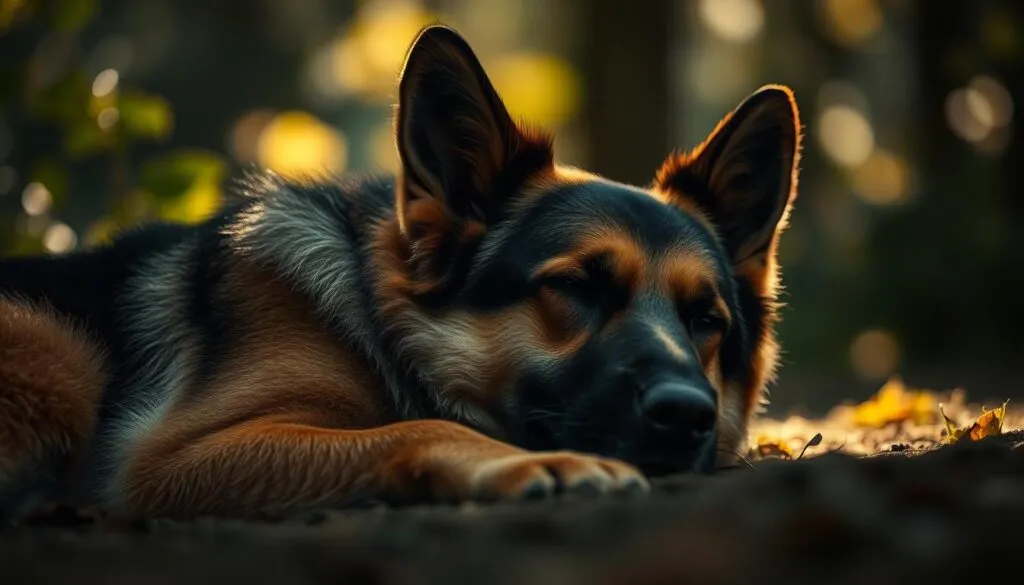Did you know that dogs spend approximately 50% of their day sleeping, with nearly 25% dedicated to dreaming? As a passionate author at pfoten-und-freunde.de, my name is Maja, and I’m excited to unravel the mysterious world of what dogs dream about in 2025.
Understanding Was träumen Hunde has become a fascinating scientific exploration. Modern research reveals that dogs experience remarkably complex sleep patterns similar to humans. During Hundeschlaf, they cycle through different stages of sleep, including the intriguing REM phase where most dreaming occurs.
Our canine companions don’t just rest—they relive experiences, process emotions, and potentially recreate memories while sleeping. Each twitch, soft bark, or leg movement might indicate they’re chasing a squirrel, playing with their favorite toy, or revisiting a memorable moment with you.
In this comprehensive guide, we’ll dive deep into the enigmatic realm of dog dreams, exploring what happens in their minds when they’re curled up and seemingly lost in slumber. Whether you’re a curious pet owner or a dog enthusiast, prepare to gain unprecedented insights into your furry friend’s nocturnal adventures.
Was bedeutet es, wenn Hunde träumen?
Understanding your dog’s dreams can provide fascinating insights into their inner world. Dogs experience complex sleep patterns that mirror human sleep cycles, revealing much about their daily experiences and emotional states. Hundeträume verstehen requires careful observation and scientific understanding.
When your furry friend starts twitching, whimpering, or moving their paws during sleep, they’re likely experiencing vivid dream sequences. Hundeträume deuten isn’t just guesswork—it’s a scientific exploration of canine consciousness.
Sleep Phases in Dogs
Dogs go through multiple sleep stages, similar to humans. Their sleep cycle includes:
- Light sleep phase
- Deep sleep stage
- Rapid Eye Movement (REM) phase
The Significance of REM Sleep
During REM sleep, dogs experience their most intense dreams. Research suggests that this phase allows them to process and consolidate daily experiences. Just like humans, dogs seem to replay memories and emotions during these dream states.
„Dogs dream about their everyday experiences, much like we do.“ – Dr. Stanley Coren, Canine Sleep Researcher
Common Dog Dream Themes
Typical dog dreams often involve:
- Chasing objects or animals
- Playing with their owners
- Exploring familiar environments
- Reliving exciting or stressful moments
By paying attention to your dog’s sleep behaviors, you can gain deeper insights into their emotional world and overall well-being.
Wie sieht der Traum eines Hundes aus?
Understanding Hundeverhalten im Schlaf reveals fascinating insights into the mysterious world of canine dreams. Dogs experience a rich inner life during sleep, with dreams that reflect their daily experiences, emotions, and instincts.
Everyday Scenarios in Dog Dreams
Your dog’s dreams often replay familiar moments from their daily life. Hundeverhalten im Schlaf can include vivid recreations of:
- Walking with their owner
- Chasing a favorite toy
- Exploring the backyard
- Interacting with other dogs
Play and Hunting Instincts in Dreams
Dogs tap into their primal instincts during sleep. Their Hundeverhalten im Schlaf can manifest as:
- Soft leg movements mimicking running
- Quiet barking or whimpering
- Twitching as if chasing prey
„Dogs dream about their everyday experiences, just like humans do.“ – Dr. Stanley Coren, Canine Sleep Researcher
Emotional Aspects of Dog Dreams
Dreams reveal your dog’s emotional landscape. Hundeverhalten im Schlaf can reflect:
| Emotional State | Possible Dream Indicators |
|---|---|
| Happiness | Soft tail wagging, relaxed breathing |
| Anxiety | Whimpering, rapid eye movement |
| Excitement | Paw movements, occasional small barks |
Each dog’s dream world is unique, shaped by their individual experiences and personality. Understanding these dream patterns can help you better connect with your furry companion.
Warum träumen Hunde?
Understanding why dogs dream has become a fascinating area of scientific research in 2025. Your furry companion’s nighttime adventures are more complex than you might imagine. Hunde REM-Schlaf plays a crucial role in how dogs process their daily experiences and emotions.
Dogs use their dreams as a powerful mental processing tool. During REM sleep, their brains work to organize and integrate memories, much like a sophisticated filing system. Recent neurological studies suggest that these dream sequences help dogs understand and remember their daily interactions.
Psychological Significance of Canine Dreams
Dreams serve several important psychological functions for dogs:
- Emotional regulation
- Memory consolidation
- Stress processing
- Cognitive development
Experience Processing Through Dreams
Your dog’s brain uses dreams to replay and analyze daily experiences. Imagine your pup reliving a fun walk or an exciting play session during their sleep. These dream sequences help them understand and learn from their interactions with the world around them.
Connecting Experiences and Memories
Hunde REM-Schlaf enables dogs to create complex neural connections. Each dream serves as a mental rehearsal, helping them integrate new information with existing memories. This process is critical for their cognitive development and emotional well-being.
Wie viel träumen Hunde tatsächlich?
Understanding your dog’s sleep patterns reveals fascinating insights into their world of Hundeschlafzyklen. Dogs spend a significant portion of their day sleeping, with dream cycles that vary dramatically based on age and breed.
Dogs experience complex sleep patterns that differ from human sleep. Their Hundeschlafzyklen typically include multiple phases of rest and active dreaming. Research shows that dogs can have up to 20 sleep cycles in a single night, with each cycle lasting approximately 20 minutes.
Average Sleep Duration for Dogs
Different dogs have unique sleep requirements. On average, dogs sleep between 12-14 hours per day, with variations depending on several factors:
- Puppies sleep more, often up to 18-20 hours daily
- Adult dogs typically sleep 12-14 hours
- Senior dogs may sleep longer due to reduced energy
Frequency of REM Phases
| Dog Size | Dream Frequency | Average REM Cycles |
|---|---|---|
| Small Dogs (e.g., Chihuahua) | Every 10 minutes | 4-5 per night |
| Medium Dogs | Every 30-45 minutes | 3-4 per night |
| Large Dogs (e.g., Great Dane) | Every 1-2 hours | 2-3 per night |
Comparing Puppies and Older Dogs
Puppies experience more frequent and shorter dream cycles, while older dogs have longer but less frequent dreams. This difference reflects their varying energy levels and brain development stages.
Understanding your dog’s Hundeschlafzyklen can help you provide better care and recognize when their sleep patterns might indicate potential health concerns.
Was sagen Hundeträume über Ihre Beziehung aus?
Your dog’s dreams are more than just random muscle twitches and quiet woofs. They’re a window into the deep emotional connection you share. Understanding the Hundekörpersprache im Schlaf can help you decode the intricate language of your canine companion’s nighttime experiences.
The Emotional Bond Between You and Your Dog
Dogs process their daily experiences through dreams, often reflecting the intimate moments you share. Their sleep patterns reveal fascinating insights into your relationship:
- Frequent gentle movements suggest a sense of security
- Calm breathing indicates a strong, trusting connection
- Soft whimpers might represent emotional processing
Detecting Stress and Anxiety in Canine Dreams
The Hundekörpersprache im Schlaf can signal underlying emotional states. Restless movements, sudden jerks, or whining might indicate your dog is experiencing stress or processing challenging experiences.
„A dog’s dreams are like an emotional diary, revealing their deepest feelings and experiences.“ – Canine Behavior Research Institute
Positive Dreams and Well-being
Not all dream signals are negative. Relaxed muscles, gentle leg movements, and occasional soft tail wags suggest your dog is experiencing positive, comforting dreams. These are signs of a healthy, happy relationship built on trust and mutual understanding.
By paying attention to your dog’s sleep behaviors, you can gain profound insights into your shared emotional landscape and strengthen your unique bond.
Können Hunde ihre Träume kontrollieren?

As we explore the fascinating world of canine dream experiences in 2025, researchers have made significant strides in understanding how dogs experience their nocturnal adventures. Was träumen Hunde reveals a complex landscape of unconscious mental activity that challenges our previous assumptions about animal cognition.
Dogs experience dreams much like humans do, with intricate neural processes that go beyond simple instinctive responses. Scientists have discovered that canine dream experiences involve multiple layers of mental processing.
Instinct vs. Conscious Control
Current research suggests that dogs have limited control over their dreams. Their dream experiences are primarily driven by:
- Unconscious memory processing
- Emotional experiences from daily life
- Physiological responses during sleep
Unique Differences Between Human and Canine Dreams
Researchers have identified key distinctions in how dogs dream compared to humans:
- Dogs have shorter REM sleep cycles
- Their dreams are more instinct-driven
- Less complex narrative structure compared to human dreams
Scientific Insights in 2025
Cutting-edge neuroscience technologies have provided unprecedented insights into Was träumen Hunde. Brain imaging techniques now allow researchers to peek into the canine subconscious, revealing the intricate mechanisms of dog dreams.
Dreams are not just random neural firings, but a complex system of memory consolidation and emotional processing.
While dogs cannot consciously control their dreams, they do experience rich, emotionally charged dream states that reflect their daily experiences and inner emotional world.
Wie oft träumen Hunde von ihren Besitzern?
Dogs have a remarkable ability to process daily experiences through their dreams, often revisiting moments spent with their beloved human companions. Hundeträume deuten reveals that the bond between a dog and its owner plays a significant role in shaping their nocturnal adventures.
Your dog’s dreams are more than random neural firings. They represent a complex emotional landscape that reflects your shared experiences and relationship dynamics.
The Influence of Owner-Dog Relationship on Dreams
Research suggests that dogs frequently dream about their daily interactions. The quality of your relationship directly impacts the content of their dreams. Positive experiences tend to create more peaceful and joyful dream scenarios.
- Close bonds generate more frequent dreams about owners
- Daily activities significantly influence dream content
- Emotional connections play a crucial role in dream formation
Shared Experiences in Canine Dreams
Hundeträume deuten shows that dogs often replay memorable moments from their day. Activities like walking, playing, or simply cuddling can become vivid dream sequences for your furry friend.
Positive and Negative Dream Experiences
Not all dog dreams are pleasant. Stressful interactions or unfamiliar experiences might also manifest in their sleep. Understanding these dream patterns can provide insights into your dog’s emotional well-being.
Dogs dream as a way of processing and understanding their world, much like humans do.
By paying attention to your dog’s sleep behaviors, you can gain a deeper understanding of their inner emotional landscape and strengthen your unique bond.
Warum träumen Hunde manchmal unruhig?
Dogs experience complex dream patterns that can sometimes include moments of anxiety and stress. Understanding why your furry friend might have restless nights can help you provide better support and comfort.
Root Causes of Sleep Anxiety
Hunde und nächtliches Bellen often stem from several underlying factors that disrupt their peaceful sleep. These can include:
- Past traumatic experiences
- Changes in home environment
- Separation anxiety
- Physical discomfort or pain
Recognizing Nightmare Signals
Your dog might display several signs during a disturbing dream:
- Whimpering or soft crying
- Rapid leg movements
- Sudden twitching
- Growling or quiet barking
Supporting Peaceful Sleep
Creating a calm sleep environment can significantly reduce nighttime stress for your dog. Consider these strategies:
| Strategy | Benefit |
|---|---|
| Consistent bedtime routine | Reduces anxiety |
| Comfortable sleeping area | Promotes relaxation |
| Gentle pre-sleep interaction | Builds security |
Remember, never wake your dog abruptly during a nightmare. Gently call their name or softly touch them to help them transition back to a peaceful state.
Ist es möglich, Hunde beim Träumen zu beobachten?
Understanding your dog’s sleep patterns can reveal fascinating insights into their inner world. Dogs experience complex dreams that reflect their daily experiences and emotions. By carefully observing their Hundekörpersprache im Schlaf, you can gain a deeper understanding of your furry companion’s nocturnal adventures.

Decoding Canine Sleep Movements
Dogs exhibit unique body language during sleep that provides clues about their dreaming state. The Hundekörpersprache im Schlaf can include several distinctive behaviors:
- Gentle paw twitching
- Soft whimpering or muffled barks
- Rapid eye movement beneath closed eyelids
- Occasional leg movements as if running
Sleep Phase Behaviors
Different sleep phases reveal unique aspects of your dog’s dream world. During REM sleep, dogs are most likely to demonstrate active dream behaviors. These moments offer a glimpse into their subconscious experiences.
| Sleep Phase | Typical Behaviors |
|---|---|
| Light Sleep | Minimal movement, slight ear twitches |
| Deep Sleep | Heavy breathing, minimal body movement |
| REM Sleep | Active leg movements, vocalization, vivid dream signs |
Observation Tips
When observing your dog’s sleep, remember these essential guidelines:
- Maintain a quiet environment
- Avoid direct physical contact
- Use soft, indirect lighting
- Watch from a comfortable distance
Pro tip: Each dog’s sleep behavior is unique. What you observe reflects their individual personality and daily experiences.
Können Sie Ihrem Hund bei seinen Träumen helfen?
Understanding your dog’s sleep patterns can transform their nighttime experience. Hundeschlaf is more than just rest—it’s a critical time for your pet’s mental and physical recovery. Creating the right environment and routine can significantly improve your dog’s sleep quality and dream experiences.
Your furry friend needs a peaceful sleeping space that promotes relaxation and reduces anxiety. Dogs are sensitive to their surroundings, and a carefully designed sleep environment can make a substantial difference in their Hundeschlaf.
Creating a Comfortable Sleep Environment
- Choose a quiet, draft-free area for your dog’s bed
- Use soft, supportive bedding that matches your dog’s size
- Maintain a consistent room temperature between 60-67°F
- Minimize loud noises and bright lights
Pre-Sleep Relaxation Techniques
Helping your dog unwind before bedtime can improve their Hundeschlaf dramatically. Consider these calming strategies:
- Gentle massage or brushing
- Short, calm walk before bedtime
- Soft background music designed for dogs
- Avoid high-energy play right before sleep
The Power of Daily Routine
Consistency is key in supporting your dog’s sleep health. Regular feeding times, exercise, and bedtime routines signal to your dog that it’s time to rest.
| Routine Element | Benefit for Hundeschlaf |
|---|---|
| Consistent Feeding Times | Regulates digestive system and sleep cycle |
| Regular Exercise | Reduces anxiety, promotes deeper sleep |
| Fixed Bedtime | Establishes natural sleep-wake rhythm |
Remember, every dog is unique. Observe your pet’s reactions and adjust strategies to suit their individual needs.
Wie hat sich das Verständnis von Hundeträumen entwickelt?
Understanding what träumen Hunde (dogs dream) about has been a fascinating journey of scientific discovery. By 2025, researchers have made remarkable progress in deciphering the complex world of canine sleep and dreams.
The exploration of dog dreams has transformed dramatically over the decades. Early observations were largely speculative, with limited scientific insight into what was happening in a dog’s mind during sleep.
Historical Perspectives on Canine Sleep
Historically, dog sleep was viewed through a simplistic lens. Researchers initially believed dogs experienced minimal dream activity. Key milestones in understanding Was träumen Hunde include:
- 1950s: Initial recognition of sleep stages in mammals
- 1970s: First scientific observations of dog REM sleep
- 1990s: Neurological studies comparing human and canine brain activity
Breakthrough Research and Technological Innovations
Modern technology has revolutionized our understanding of dog dreams. Advanced neuroimaging techniques and wearable monitoring devices now allow unprecedented insights into canine sleep patterns.
Technological Impact on Behavioral Research
In 2025, cutting-edge technologies like AI-powered brain mapping and sophisticated sleep tracking systems have dramatically expanded our knowledge. Researchers can now analyze intricate details of dog dream experiences with remarkable precision.
The ongoing research continues to reveal the fascinating complexity of canine cognitive processes during sleep, promising even more exciting discoveries in the years to come.
Fazit: Besonders in 2025, was wollen wir über Hundeträume lernen?
As we look toward advancing canine sleep research, the mysteries of dog dreams continue to fascinate scientists and pet owners alike. By 2025, researchers are exploring deeper connections between a dog’s daily experiences and their nocturnal brain activity. Neuroscientists are particularly interested in understanding why dogs bark in their sleep, which could reveal intricate details about their emotional processing and memory consolidation.
Technological innovations are providing unprecedented insights into canine dream patterns. Advanced neuroimaging techniques allow researchers to map brain regions activated during different sleep stages. This research suggests that dream content may vary significantly between dog breeds, revealing unique neurological responses that reflect individual temperaments and genetic backgrounds.
Your understanding of your dog’s dreams can transform how you interact with them. Veterinary behaviorists recommend creating stable environments that support healthy sleep cycles. Observing subtle movements during sleep, like gentle paw twitches or soft whimpers, can offer glimpses into your dog’s inner emotional landscape. As research progresses, we’ll likely develop more sophisticated methods to interpret and support our canine companions‘ dream experiences.
Emerging Research Directions
Future studies aim to decode the complex neurological mechanisms behind warum bellen Hunde im Schlaf. By integrating data from multiple disciplines, researchers hope to unlock deeper comprehensions of canine cognitive processes during sleep. Your role as a pet owner becomes crucial in contributing to this expanding field of knowledge.
FAQ
Do dogs really dream like humans do?
How can I tell if my dog is dreaming?
What do dogs typically dream about?
Do puppies dream differently from older dogs?
Can dogs have nightmares?
How much do dogs actually dream?
Can dogs dream about their owners?
How can I help my dog have better sleep?
Why do dogs sometimes bark or move during sleep?
Do all dog breeds dream the same way?
- Italienisches Windspiel kaufen: Ratgeber & Tipps zur Hundewahl - Oktober 11, 2025
- Stabheuschrecke Haltung: Tipps für erfolgreiche Pflege - Oktober 9, 2025
- Seltene Katzennamen weiblich – Die schönsten Ideen - Oktober 8, 2025

